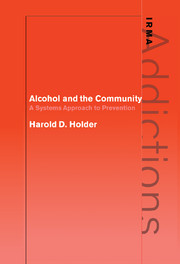Book contents
- Frontmatter
- Contents
- Series editor's preface
- Acknowledgements
- 1 The community system of alcohol use and alcohol problems
- 2 Consumption System
- 3 Retail Sales Subsystem: alcohol availability and promotion
- 4 Formal Regulation and Control Subsystem: rules, administration, and enforcement
- 5 Social Norms Subsystem: community values and social influences that affect drinking
- 6 Legal Sanctions Subsystem: prohibited uses of alcohol
- 7 Social, Economic, and Health Consequences Subsystem:community identification of and responses to alcohol problems
- 8 Community-level alcohol problem prevention
- References
- Index
6 - Legal Sanctions Subsystem: prohibited uses of alcohol
Published online by Cambridge University Press: 22 September 2009
- Frontmatter
- Contents
- Series editor's preface
- Acknowledgements
- 1 The community system of alcohol use and alcohol problems
- 2 Consumption System
- 3 Retail Sales Subsystem: alcohol availability and promotion
- 4 Formal Regulation and Control Subsystem: rules, administration, and enforcement
- 5 Social Norms Subsystem: community values and social influences that affect drinking
- 6 Legal Sanctions Subsystem: prohibited uses of alcohol
- 7 Social, Economic, and Health Consequences Subsystem:community identification of and responses to alcohol problems
- 8 Community-level alcohol problem prevention
- References
- Index
Summary
Introduction
The Legal Sanctions Subsystem reflects the community's use of police powers to respond to and control alcohol-involved behaviors and events that are defined as illegal. Along with the Formal Control and Regulation Subsystem, the Legal Sanctions Subsystem is also involved in detecting and punishing those who violate specific rules concerning the possession and use of alcohol. The purpose of enforcement is not only to punish those who violate the laws or rules, but also to deter or prevent such behaviors or events through the threat of punishment.
Behaviors and events subject to enforcement within the Legal Sanctions Subsystem can include public intoxication or public drinking, alcoholinvolved violent behavior, illegal sale of alcoholic beverages, drinking in places where it is prohibited (such as parks or beaches), and driving under the influence of alcohol (DUI). This chapter first briefly summarizes enforcement considerations in each of these areas. The rest of the chapter focuses primarily on drinking and driving, which is the dominant concern of this subsystem in many industrialized communities. The discussion of drinking and driving provides a detailed example of how the Legal Sanctions Subsystem functions and interacts with other subsystems in all aspects of enforcement.
Areas of enforcement within the subsystem
A common function of the Legal Sanctions Subsystem is detection and deterrence of public intoxication. Even where alcohol sales and consumption are legal, many communities in industrialized countries have defined intoxication in public view as illegal. As a result, the offense of public intoxication can consume considerable police time and court resources.
- Type
- Chapter
- Information
- Alcohol and the CommunityA Systems Approach to Prevention, pp. 97 - 112Publisher: Cambridge University PressPrint publication year: 1998



